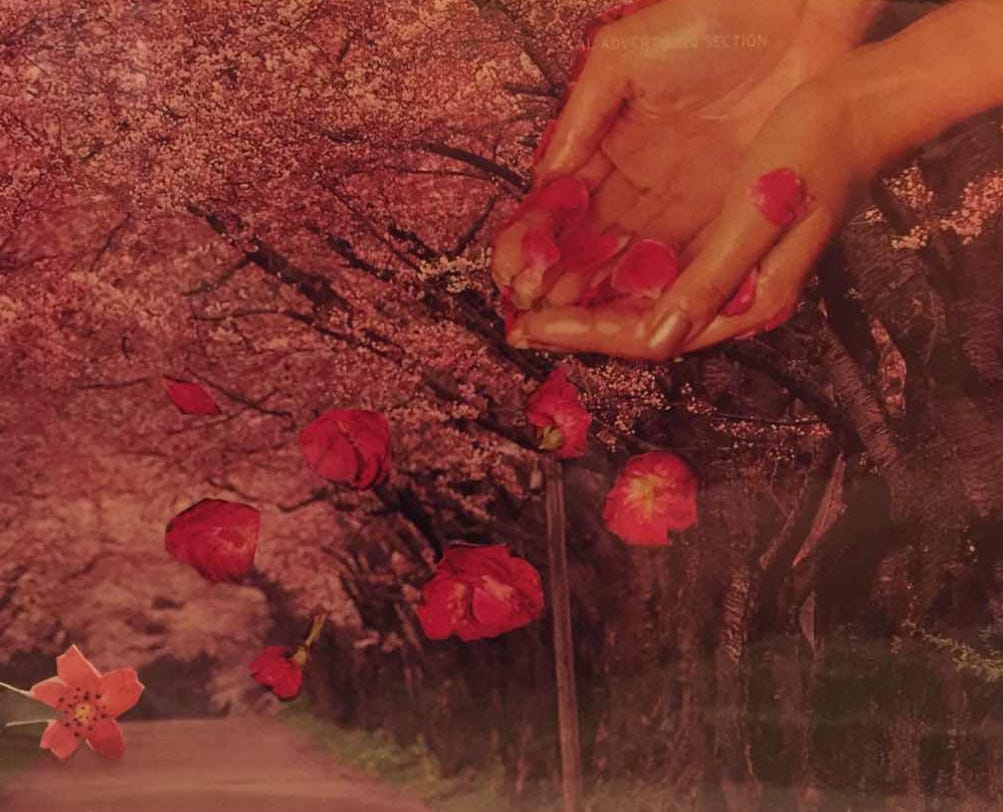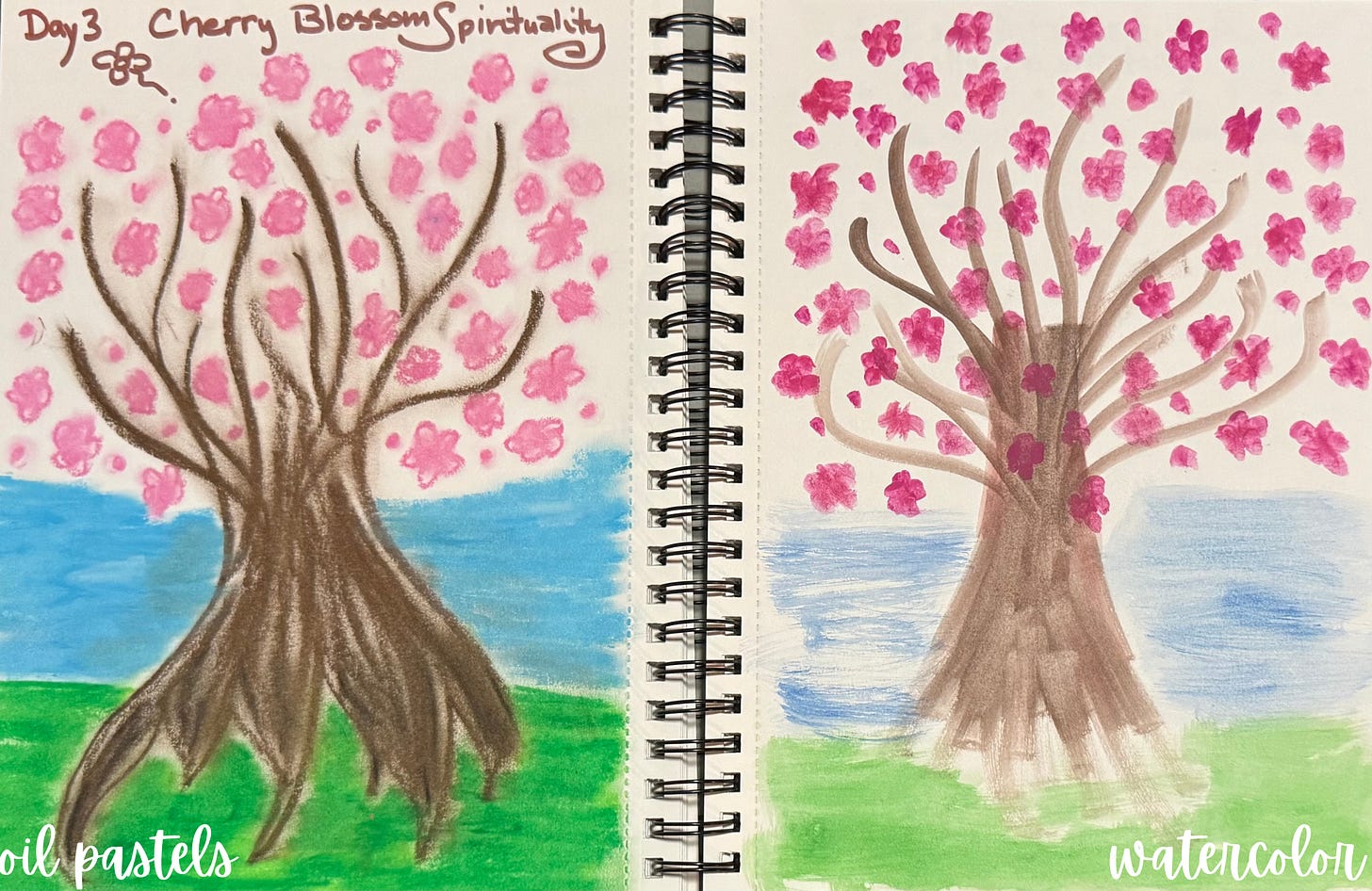a blind child
guided by his mother
admires the cherry blossoms
~a haikai, or a haiku1 by Takarai Kikakou, 17th century Japanese haiku poet, translator unknown.
Many years ago I experienced a guided meditation based on this haiku by Kikakou.2 I am always deeply affected by guided meditation but this one was especially profound, and I still remember the way it unfolded in my imagination. It is summer. It is hot, but there is a gentle breeze flowing across a meadow of bright green grass. As I lay down on my back in the grass, I feel it tickle the backs of my legs and a smile flickers in my soul. My breathing deepens. My body relaxes into the earth and as I close my eyes to the sun's warmth, I become the child. Suddenly, I feel a single cherry blossom kiss my cheek. And another. And another. With each pink kiss that gently brushes my cheek, I breathe … inhaling deeply, intentionally, thoughtfully … exhaling to emptiness, letting go, releasing, freeing my soul from all the thoughts running circles around my mind, creating meaningless chaos. With each inhale … exhale … release, I draw closer to who I am in the center of myself, the place in my soul where I am most like I was created to be. This is Cherry Blossom Spirituality.
The Cherry Blossom meditation stayed with me as I pondered not only the experience of the child in the first line of this beautiful Haiku but also the experiences of the mother in the second line and the unmentioned but very present tree through it’s cherry blossoms in the third line, holding space for the child and the mother. The mother was the guide but the Cherry Blossom tree was the wisdom teacher, for me, offering gentle healing energy to the world through the delicate, flowers that float along with the breeze wherever they are carried, doing only what is theirs to do.
One day soon after the guided meditation, I came to my box of images and within an hour I had created a SoulCollage®3 card to honor the energy I continue to receive from my experience of pondering the Cherry Blossom haiku. SoulCollage® helps us know ourselves by inviting our inner voices to speak through the energy of the images and the cards we create with them.
My favorite quote to illustrate the SoulCollage® reflective process is by Meister Eckhart, a 13th century mystic:
Whenever the soul wants to experience something, she throws out an image in front of her and steps into it.
When I ask myself, “Who are you?” I step into the energy of this card, and a voice within me responds …
I am “Healing Waters.”
I am one who (IAOW) loves pink flowers and poetry.
IAOW appreciates and offers beauty.
IAOW who knows the journey is hard from personal experience.
IOAW listens and holds space for others.
IAOW reaches out and pours healing waters upon the world.
What gift do you bring me? I bring you the gift of healing and wholeness
What do you want from me? As you have received this grace-filled gift, I want you to release grace into the world. This is yours to do.
This. Yes. This feels authentic. I have tended to this vocation, offering spiritual practices of healing and wholeness for many years. And yet, with each step on the labyrinth of life, the journey deepens.
On day three of a guided Summer Solstice journey, the memory of Kikakou’s haiku bubbled up in my consciousness, and I wrote “Cherry Blossom Spirituality” at the top of the page in my personal art journal. I spent precious time, “just making art” with oil pastels and watercolor, processing all that was coming to me, not trying to create something of value to share with you or anyone else, even though in the end I am. These 2 pages of art-making have value, not because they are “good” or pretty, but because their creation brought me the concept of Cherry Blossom Spirituality. With each stroke of color blessing the page in the same way the cherry blossoms kissed my cheek that day so long ago, Cherry Blossom Spirituality came alive in my heart, mind, and soul.
Cherry Blossom Spirituality is about inhaling … exhaling … releasing. Suddenly, I realize how important gentle release is to the spiritual journey that is our life. This I learned from my wisdom teacher, the Cherry Blossom Tree!
Inhale … Exhale …
One of the reasons I love breath prayer is because breathing keeps us alive. Breathing isn’t a choice, but we can choose how we breathe. We can choose whether to breathe consciously or unconsciously in each given moment. When we breathe consciously, we can choose to allow breathing to be a part of our soul care. When I breathe, I am able to feel how I feel, regulating the impact of my feelings.
How conscious are you of your breathing? Pause for a moment. Inhale … Exhale … What do you notice? How do you feel? What are you thinking? What do you sense in your body?
How is or how can breathing be a part of your soul care? As we become ever more conscious of our breathing, let us simply breathe and notice how our body is affected by our breathing. Let us not try to change anything, but as we allow our body to lead us intuitively, that may lead to change.
Release
“Release” is different for everyone, and our need and desire for release changes as our life journey unfolds. If you are a feeler rather than a thinker, your emotional release may be much different. Perhaps it is so familiar to you, it is an organic movement, and this may make it even more difficult to notice nuance in your emotions.
For me, naming and claiming my emotions is difficult. I am deeply distressed about what is happening in our country right now. Let’s be real. Life as an American will never be the same. When I stop and take the time and space to breathe deeply, noticing my inhale … exhale … I notice that I feel sad, powerless, tired, and overwhelmed. Hopelessness knocks on my door, and apathy calls my name with insistence. “Cindy, don’t feel, all shall be well.”4 OK. And yet, I have found that when I breathe deeply and notice, I am vibrantly alive and energized in my emotions. I am in the process of releasing their power over me. When the power of my emotions is released, I think more clearly. I can say with assurance, “I may be sad but I am not powerless. I may be tired but I am not overwhelmed. I am not hopeless and I will not give up. Suddenly, I turn my back on apathy, and embrace clarity and purpose.
All those sweet cherry tree blossoms came gently kissing my cheeks, not just as art-making but in other ways as well, to remind me to breathe and to feel and to release what is not mine to do so that I can embrace what is mine to do.
Pause for a moment. Inhale … Exhale … What do you notice? What is bubbling up for you? Know that small releases are happening just in breathing and noticing.
If you continue breathing with intention and putting one foot in front of the other, you will journey into deeper release, clarity and purpose. You might even find a haiku or two or more being birthed!
Cherry Blossom
Spirituality
Inhale … Exhale … Release
~Cindy Serio
As time unfolds, may you find sweet cherry tree blossom kisses drifting into your consciousness as you breathe and become who you were created to be …
Until next time, keep breathing
Haikai was a highly structured form of Japanese poetry, often witty or humorous, from which Haiku emerged. Kikakou and his mentor, Matsuo Basho, were instrumental in this poetic development, and they emphasized simplicity, nature, and spirituality. Their haiku was often deeply poignant. In just a few words, they invited you to think deeply. Today, the usual form use to write haiku consists of 17 syllables (5-7-5) but the rhythm of this haiku is 3-6-7. There are several reasons for this, the main reason being that we do not really know the number of syllables in the original language. At the same time, neither Basho nor Kikakou stressed over the number of syllables. The weaving together of simplicity and depth is key for Haiku writers, so if you need a couple more or less syllables, don’t stress!
from Awakening the Creative Spirit: Bringing the Arts to Spiritual Direction, Chapter 15: “Arts-Centered Supervision” by Kayce Stevens Hughlett and Christine Valters Paintner
SoulCollage® is a fun, intuitive and creative collage process. I am a trained facilitator and this process is one of the core spiritual practices of my life and my online and in person workshops, retreats, and individual spiritual companioning sessions.
“All shall be well, and all manner of things shall be well” is a powerful and important quote by Julian of Norwich. And yet, there is danger when we use this quote in the wrong context. These words can be shared as a way to practice spiritual bypassing, which means to use meditative spiritual practices to suppress emotions before processing them and, by extension, preventing those they share the quote with from processing and sharing theirs. This emerges as unconscious resistance to feeling unpleasant emotions so when this quotes arises in my consciousness, I will check my emotions for spiritual bypassing before embracing the power of Julian’s words, “all shall be well.”







